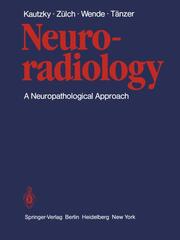-
Zusatztext
-
Contents: Intracranial Pressure and Mass Displacements of the Intracranial Contents. - Special Neuropathology - Morphology and Biology of the Space-Occupying and Atrophic Processes with Their Related Neuroradiological Changes of Diagnostic Significance. - Cerebral Angiography. - Pneumoencephalography. - Myelography. - Spinal Angiography. Discography. Ossovenography and Epidural Venography. References. Subject Index.
-
-
Schlagzeile
- InhaltsangabeA. Intracranial Pressure and Mass Displacements of the Intracranial Contents.- I. Intracranial Anatomy and Mass Displacements.- II. Mass Displacements and Space-Occupying Lesions.- 1. Etiology of Localized and Generalized Intracranial Pressure.- 2. Herniation into the Cisterns.- 3. Development of Occlusive Hydrocephalus.- 4. Significance of Site and Type of Space-Occupying Lesions on the Type of Intracranial Mass Displacement.- a) The Hemispheric Processes.- b) The Paramedian, Especially Thalamic and Basal Ganglia Tumors.- c) Obstructions to the Ventricular Fluid Pathways in or Near the Midline.- III. Mass Displacements by Atrophic Processes.- B. Special Neuropathology - Morphology and Biology of the Space-Occupying and Atrophic Processes with Their Related Neuroradiological Changes.- I. Space-Occupying Intracranial and Spinal Processes.- a) Predilections.- b) The Classification of Brain Tumors According to the World Health Organization.- 1. Tumors of Neuroepithelial Tissue.- 2. Tumors of Nerve Sheath Cells.- 3. Tumors of Meningeal and Related Tissues.- 4. Primary Malignant Lymphomas.- 5. Tumors of Blood Vessel Origin.- 6. Germ Cell Tumors.- 7. Other Malformative Tumors and Tumor-Like Lesions.- 8. Vascular Malformations.- 9. The Tumors of the Anterior Pituitary.- 10. Local Extensions from Regional Tumors.- 11. Metastatic Tumors and Unclassified Tumors.- 12. Less Common Tumors of the Base of the Skull.- 13. Space-Occupying Processes of the Spinal Canal.- 14. Space-Occupying Lesions Other than Neoplasms.- 15. Grading of Malignancy.- II. Atrophic Cerebral Processes.- III. Changes Following Trauma to the Skull and Brain.- 1. Injuries Occurring as a Result of Falls or Secondary to Blunt Instruments (Flat Force, Circumscribed Force).- 2. Traumatic Hemorrhages.- 3. Traumatic Cysts.- 4. Traumatic Brain Edema.- 5. Special, Rare Posttraumatic Events (Pneumocephaly, Carotid-Cavernous Fistula).- IV. Consequences of Craniocerebral Trauma as Revealed by Radiologic Contrast Procedures.- V. The Pathogenesis of Infarcts.- VI. Aneurysms and Arteriovenous Malformations.- VII. Hypertensive Intracerebral Hemorrhage.- C. Cerebral Angiography.- I. History.- II. Technique.- 1. Injection of the Contrast Medium.- a) Puncture Methods.- b) Catheter Techniques.- c) Retrograde Injection Techniques.- d) Catheter Techniques and Retrograde Angiography in Children.- 2. The Contrast Media.- 3. X-Ray Technique.- a) Magnification Angiography.- b) Subtraction.- 4. Dangers and Complications of Cerebral Angiography.- III. The Normal Cerebral Angiogram.- a) The Arterial Phase of the Internal Carotid Artery Angiogram.- b) The Capillary and Venous Phases of the Internal Carotid Artery Angiogram.- c) The External Carotid Angiogram.- d) The Arterial Phase of the Vertebral Angiogram.- e) The Venous Phase of the Vertebral Angiogram.- IV. The Pathological Intracranial Angiogram.- 1. Intracranial Space-Occupying Lesions.- a) Displacement of Normal Blood Vessels.- b) Pathological Vascularization in Space-Occupying Processes.- 2. The Angiogram in Head Injuries.- 3. The Diagnosis of Primary Intracranial Vascular Disease.- a) Arterial Aneurysms.- b) Arteriovenous Malformations.- c) The Carotid-Cavernous Fistula.- d) Vascular Stenoses and Vascular Occlusions.- e) Intracerebral Hemorrhage.- f) Disturbances in Venous Outflow.- 4. Cerebral Circulatory Standstill and Brain Death.- V. Special Angiographic Procedures.- 1. Angiography of the Ophthalmic Artery.- 2. Orbital Venography.- 3. Direct Sinography.- 4. Angiography of the Jugular Vein.- D. Pneumoencephalography.- I. History.- II. Injection Technique.- 1. The Lumbar Pneumoencephalogram.- 2. Suboccipital (Cisternal) Pneumoencephalography.- 3. Ventriculography.- III. Radiologie Technique.- a) Recommended Standard Technique.- b) Positioning the Patient and Setting of the Apparatus for the Films.- c) The Causes of Nonfilling of the Ventricular System.- d) Unilateral Filling.- e) The 24-h Pneumoencephalogram.- IV. Gas Resorption.- V. A
Detailansicht
Neuroradiology
A Neuropathological Approach
Kautzky, Rudolf/Zülch, Klaus J/Wende, S et al
ISBN/EAN: 9783642816802
Umbreit-Nr.: 4370699
Sprache:
Englisch
Umfang: xii, 324 S., 176 s/w Illustr., 324 p. 176 illus.
Format in cm:
Einband:
kartoniertes Buch
Erschienen am 22.12.2011
Auflage: 1/2011


